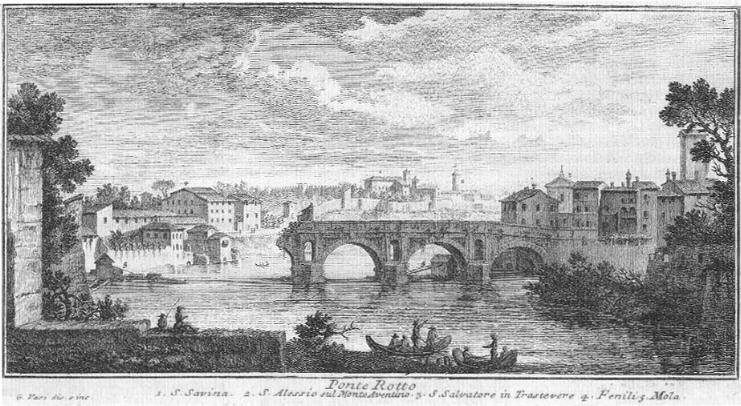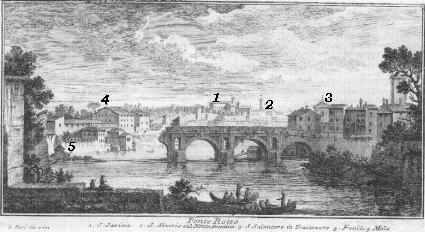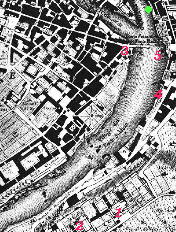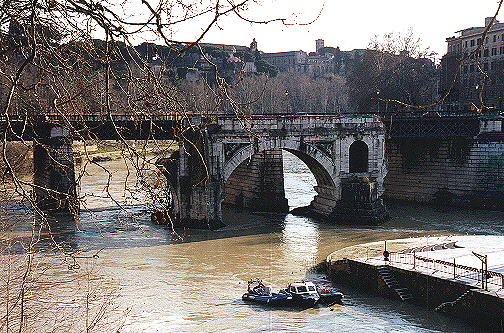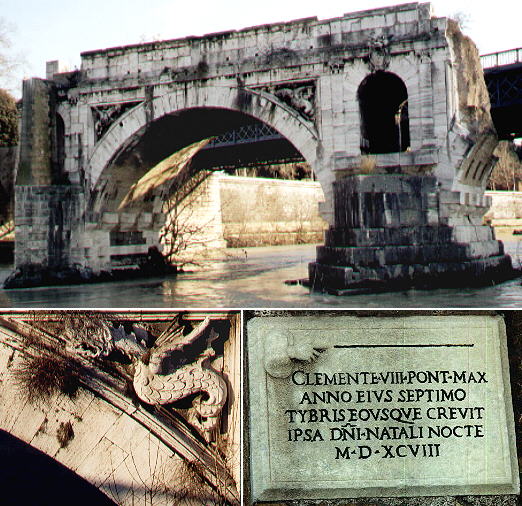

Ponte Rotto (Book
5) (Map
C3) (Day 5) and (Day 6) (View C9)
(Rione Ripa) and (Rione Trastevere)
In this plate:
The plate by Giuseppe Vasi
Today's view (S. Salvatore a Ponte Rotto)
Ponte Rotto
The Plate (No. 94 - ii)
Vasi shows in this plate the Aventine, the only historical hill of Rome which is touched by the river. The view is taken from the green dot in the small 1748 map here below.
In the description below the plate Vasi made reference to: 1) S. Sabina ;
2) S. Alessio ; 3) S. Salvatore in Trastevere; 4) Fenili (haylofts); 5) Mill.
1) and 2) are shown in detail in other pages.
Today
Only one arch of the broken bridge is left. The reshaping
of the river bed in the late XIXth century led to the loss of the little church of S. Salvatore and of part of the bridge.
Ponte
Rotto
The bridge rebuilt on the ruins of an old Roman bridge by Gregorius
XIII in 1575 was destroyed by a great flood on Christmas Night of the year
1598. This flood is recorded by a plate near S. Spirito
in Sassia. The dragon is the heraldic symbol of Gregorius XIII.
Excerpts from Giuseppe Vasi 1761 Itinerary related to this page:
Rovine del ponte di s. Maria, detto Rotto
Questo si disse da alcuni ponte Senatorio, da altri Janiculense, e fu il secondo ponte,
che fosse eretto presso Roma, e però tutta la spiaggia, che era tra il suddetto ponte
Sublicio, e questo dicevasi inter duos pontes: perciò quivi deve intendersi essere stata
la statua di Simon Mago, che descrive s. Giustino martire, e non fra li due ponti
dell'isola Tiberina, come fin ora si è creduto. Ebbe principio questo ponte da
Marco Fulvio Censore, e poi fu compito da Publio Scipione Africano, e L. Mammio Censori;
dipoi essendo per la vecchiezza in parte rovinato, da Giulio III. fu rifatto; ma
avendo altra volta pericolato, fu fatto di nuovo da Greg. XIII. l'an. 1575. e
finalmente nel 1598. seguendo una grande inondazione rovinarono due archi, e
perciò rimanendo in abbandono, dicesi Ponte rotto, ed ancora di s. Maria per la divisata
chiesa, che sta da questa parte.
Chiesa di s. Salvatore a Ponte Rotto
A fianco del ponte Senatorio, oggi rotto, si vede questa chiesa, la quale molto dovette essere
cospicua ne' secoli passati, poichè conservandosi in essa i corpi de' ss. Proto, e Giacinto, s. Simmaco
Papa vi fece la confessione di argento; ma nell'ultima ristaurazione fatta l'anno 1471. da Sisto IV. le
colonne della nave di mezzo furono incluse entro i pilastri, e li sagri Corpi furono trasportati alla
chiesa di s. Giovanni de' Fiorentini.
|
Next plate in Book 5: Spiaggia verso la Bocca della Verità
Next step in Day 5 itinerary: Chiesa ed Ospedale
di S. Galla
Next step in Day 6 itinerary: S. Maria in Cappella
Next step in your tour of Rione Ripa: Ponte Quattro Capi

Go
to  or to Book
5 or to my Home
Page on Baroque Rome or to my Home Page on Rome
in the footsteps of an XVIIIth century traveller.
or to Book
5 or to my Home
Page on Baroque Rome or to my Home Page on Rome
in the footsteps of an XVIIIth century traveller.
|


